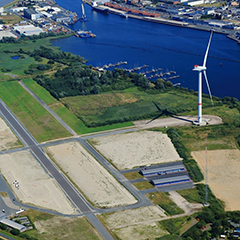Large component layout confirmed
Following the approval of funding for the Hydrogen Lab Bremerhaven at the former Luneort airfield, the project work started behind the scenes first of all. The first major step was to commission a general contractor to design specific layout plans for the facilities. This is a fundamental prerequisite for any necessary permits. The connection of the test field to the virtual grid of Fraunhofer IWES’ Dynamic Nacelle Testing Labora-tory (DyNaLab) large-scale testing facility and the generation of the electrolysis energy from wind power is a unique selling point.
There are numerous processes to complete before the complex system of electrolyzers, compressors, and the switchgear is coordinated – all without a blueprint, as there are no comparable projects at present. For example, the connection of the hydrogen, power, and data lines up to the Fraunhofer DyNaLab requires both expertise and creativity on the part of the general contractor Wenger Engineering. “The planned test field is a world first and represents a significant contribution to the energy transition for the region. We are very proud to be realizing this project in cooperation with Fraunhofer IWES,” explained Dr. David Wenger, CEO of Wenger Engineering GmbH.
The Hydrogen Lab Bremerhaven should produce green hydrogen – around 1 ton per day when working at full capacity – and distribute it with the help of regional partners. The term “green” means CO2-free – as the energy used to split water into hydrogen and oxygen comes from wind. The European Union and the Federal State of Bremen have provided €16 million for the construction of the test field in the scope of the Hydrogen – Green Gas for Bremerhaven project.
The research partners Bremerhaven University of Applied Sciences, Technologie-Transfer-Zentrum (ttz) Bremerhaven, and Fraunhofer IWES are investigating specific applications in the fields of decentralized grids, alternative fuels, mobility and logistics, offshore site exploration, and the food industry.
The potential uses of the colorless gas are manifold, from synthetic fuels for vehicles and a methane substitute for the gas heating of buildings up to decarbonization for industrial processes. The neighboring Lune Delta business estate currently being developed by the Bremerhavener Gesellschaft für Investitionsförderung und Stadtentwicklung mbH (BIS) is also set to benefit from the technology. “The realization of the electrolyzer test field is groundbreaking for Bremerhaven as a hydrogen hub and will lay the foundations for further projects. We are thus taking a decisive step towards the energy transition and setting a milestone for the introduction and use of hydrogen technologies in Bremerhaven,” explained Dr. Saskia Greiner, Hydrogen Innovation Manager at BIS.
“Once the Hydrogen Lab Bremerhaven is up and running, we will be in a position for the first time to measure the performance of electrolyzers in direct connection with wind energy independently of the manufacturer and validate it in the long term. It will also be possible to address many other topics such as grid integration and island grids as well as water supply from seawater”, added Nora Denecke, Head of department at Fraunhofer IWES and project coordinator. She said, that the concept of the test field allows Fraunhofer IWES to expand its research and testing activities in a modular way and to adapt them individually to the requirements of industrial customers.
There is always plenty for pioneers to learn, which is why the exchange of experiences between those working at the site is of central importance. The H2BX association in Bremerhaven offers networking opportunities to all those interested in the energy transition.
________
Fraunhofer IWES
Fraunhofer IWES secures investments in technological developments through validation, shortens innovation cycles, accelerates certification procedures, and increases planning accuracy by means of innovative measurement methods in the wind energy and hydrogen technology sectors. At present, around 250 academics and employees as well as more than 100 students are employed at the five sites: Bremerhaven, Hanover, Bremen, Hamburg, and Oldenburg.



























